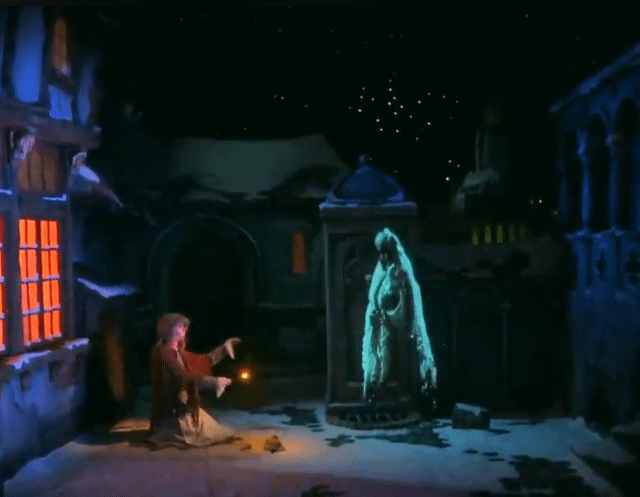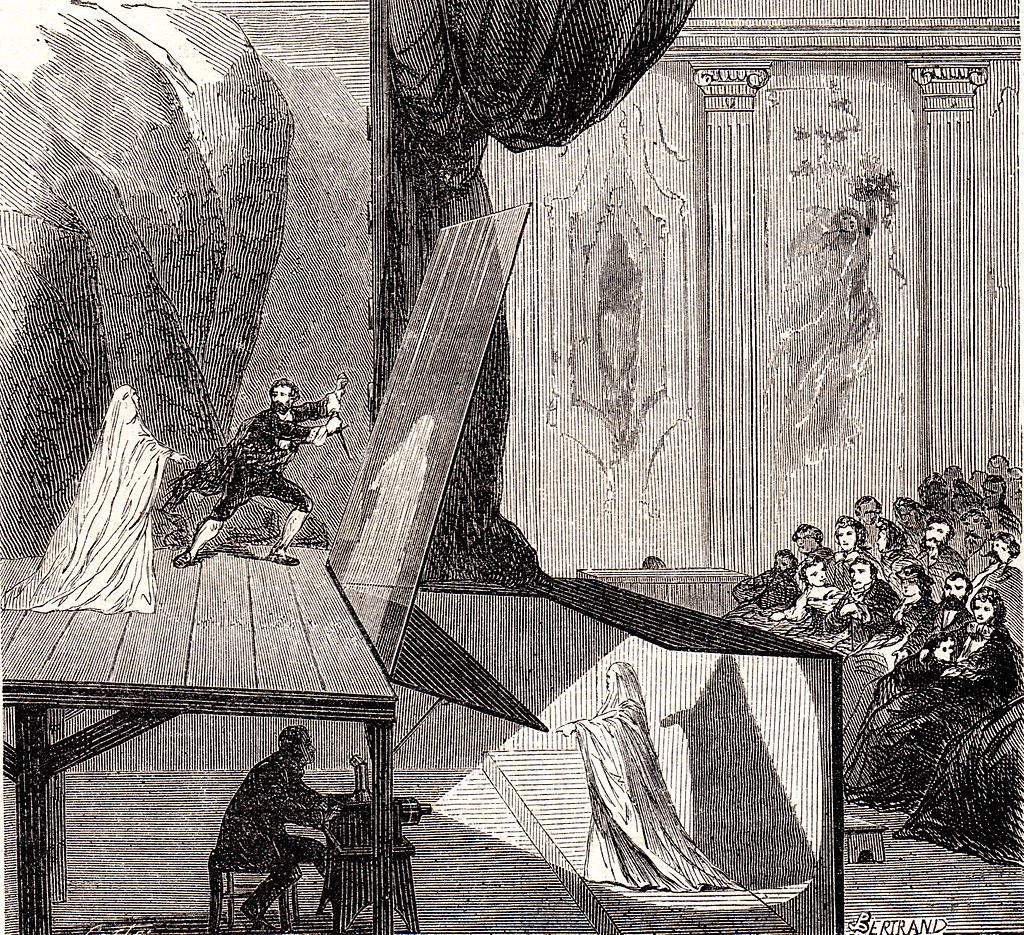Through a clever placement of mirrors and lamps, a ghost appears on the Victorian stage. This technique, called Pepper's Ghost, has been a popular visual illusion since the nineteenth century. Since then, the technique has been present not only in plays but is also frequently used in theme parks, magic shows, museums, and the music world. Pepper's Ghost is even used to bring the dead back to life. In this blog post, we introduce what Pepper's Ghost is and show how it has been used since the nineteenth century to present both entertaining and emotionally meaningful illusions.
As the image at the top of this blog post shows, a Pepper's Ghost is a projection of a hidden object onto a slanted glass plate. This creates the illusion of a semi-transparent object floating on the stage. The first description of this optical illusion was by Giambattista della Porta in his 1558 work Magia Naturalis.. However, it was John Henry Pepper who demonstrated the technique in 1862.
The semi-transparent quality of the image creates a ghostly effect. This is why it is widely used for horror stories and attractions. For example, think of the ghostly appearances in Charles Dickens’ A Christmas Carol. But it is also widely used outside the theater. It often appears in magic shows and almost every theme park extensively uses Pepper’s Ghost. For instance, it is consistently featured in the haunted houses at Disneyland to show waltzing ghosts, among other things. There are also many Pepper’s Ghosts in the Efteling. In the (now closed) Haunted Castle, there were dozens of Pepper’s Ghosts, including a skull in a glass ball, violin-playing hands, and a ghost mill where the dead dance around. There are also several to be found in the Fairytale Forest. For example, the malevolent spirit of the Chinese emperor appears through a Pepper’s Ghost in the fairy tale ‘The Chinese Nightingale’. In The Magic Table, a fully set table is conjured up using a Pepper’s Ghost. In the fairy tale about The Little Match Girl, an animatronic doll kneels in the snow. As she takes her last breath, the spirit of the dying girl floats 'to God's paradise' through the use of a Pepper’s Ghost.

But many Pepper’s Ghosts can also be found in the heritage sector. The Children's Museum in Indianapolis, for example, promotes the use of Pepper’s Ghost as follows:“Watch this miniature room come to life and imagine what it’s like to live there!” There is also a beautiful example in the Museum Het Grachtenhuis in Amsterdam, where the history of a canal house is told. A miniature of the canal house functions as the backdrop on which twenty different stories are projected. Through the appearing and disappearing stories, this installation shows how an everyday house on the canal has been the stage for many past lives.
These examples nicely show what Pepper’s Ghost excels at: Pepper’s Ghost projects the invisible into the visible, the extraordinary into the everyday, the past into the present. This places something fascinatingly supernatural in the ordinary.
As evident from the examples mentioned above, Pepper’s Ghost is often combined with other media forms, such as animatronics (see The Little Match Girl), or miniatures (see the miniature canal house). In times of electricity, animatronics, holograms, and AI, Pepper’s Ghost has remarkably stood the test of time.
We also see this strongly reflected in the use of Pepper’s Ghost to bring celebrities back to life. Michael Jackson, Whitney Houston, Elvis, André Hazes, Tupac,—all of these celebrities have been resurrected using Pepper’s Ghost. You can even attend a tour of ABBA where the songs are performed by so-called ‘Abbatars‘. Let's take a closer look at Tupac's performance at Coachella 2012, fifteen years after his death.
Although this was not the first use of Pepper’s Ghost to bring a celebrity back to life, it became one of the most famous examples of a performance by a deceased artist. And we can call it a performance because it is not old material from when Tupac was still alive. Through a combination of Pepper’s Ghost and a digitally generated voice of Tupac, we see the rapper 'live' addressing the audience: 'What the fuck is up Coachella!!!'
We see several elements here that we discussed above. The use of Pepper’s Ghost first and foremost has an enchanting effect: something seems to be present that is not there, it is more than a recording of a performance, it is a presence. Clearly mediated through a special effect, but still a form of a more authentic presence than a showing of old film footage. Additionally, we see how Pepper’s Ghost can be mixed with other techniques. Here it involves an early form of digitally generated content of a deceased artist. If you have a large enough collection of someone's voice, you can create new texts with advanced cut-and-paste work (a technique that will be seen even more often with recent AI developments). Finally, we see a deceased celebrity brought to life through this technique. The audience experiences a supernatural presence of a deceased celebrity and, in the presence of this apparition, becomes part of something greater than just a concert.
Sure, here is the translation of the additional text into English: --- We see similar aspects in other forms of using Pepper’s Ghost to bring deceased celebrities back to life. For example, the ‘André Hazes Resurrection Hologram’ is not presented as a past performance by Hazes, but as a new performance, a resurrection of the deceased. It is notable how the technique is most often used for what can be considered secular saints. Elvis, Tupac, and Hazes are examples of celebrities who have undergone a kind of sacralization after their deaths, including pilgrimage sites (Graceland became a true pilgrimage site), relics (Irene Stengs describes how, after André Hazes' death, an extensive commemorative culture emerged, where Hazes' ashes were used in various commemorative rituals and practices), and a refusal bordering on conspiracy theories to believe that these supernatural individuals are really dead (this applies to both Tupac and Elvis).
Pepper’s Ghost seems to function here not only as entertainment but also as a way to make death not the end of an authentic presence. It shows how special effects can be used to create an intimate experience of a celebrity's presence for fans.
As we have shown, Pepper’s Ghost has always been able to connect with new technologies. From Victorian theater to animatronics, from miniatures to digitally generated concerts. It travels from the theater to the theme park, from the museum to the concert stage. It has continually enchanted and moved people by playing with the boundaries of the present and the absent. In the near future, it is expected that Pepper’s Ghost will be applied in combination with generative AI. Funeral homes have already developed the technology to create a self-speaking avatar of, for example, a deceased family member. Thus, Pepper’s Ghost remains enchantingly connected to spooky entertainment but also to deeper questions around the presence and absence of what is dear to us.
